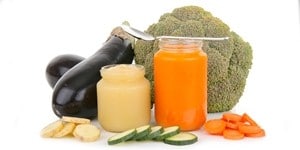 A new study conducted by the U.S. Centers for Disease Control and Prevention, published in the journal Pediatrics, has found that many packaged foods given to toddlers are high in salt and added sugar.1 While not every food group aimed at toddlers had this issue, all in all the CDC expressed concerns that commercial foods targeted at infants and toddlers could raise long-term health concerns. Particularly, food habits formed at a young age can lead to dietary choices later in life, and therefore foods for toddlers need to especially be monitored for their nutritional content.
A new study conducted by the U.S. Centers for Disease Control and Prevention, published in the journal Pediatrics, has found that many packaged foods given to toddlers are high in salt and added sugar.1 While not every food group aimed at toddlers had this issue, all in all the CDC expressed concerns that commercial foods targeted at infants and toddlers could raise long-term health concerns. Particularly, food habits formed at a young age can lead to dietary choices later in life, and therefore foods for toddlers need to especially be monitored for their nutritional content.
The study
To conduct the study, researchers used a database of nutrition facts, along with labels on toddler foods found in major grocery outlets, from more than a thousand toddler foods and drinks based on information from 2012. The team then categorized each food by its main ingredients and the amount usually eaten on one occasion (reference amounts customarily consumed per eating occasion [RACC]) based on portions provided by the U.S. Food and Drug Administration. This allowed the food researchers from the CDC to determine how much sodium and sugar would be consumed by a toddler during a normal meal. The results were somewhat troubling. For starters, the team found that 72 percent of toddler dinners were high in sodium.1 Of 79 mixed grain and fruit dishes, 35 had more than 35 percent of the calories being provided by sugar. Moreover, the study revealed that the majority of breakfast snacks aimed at toddlers, such as cereal bars, pastries and fruits, contained some level of added sugar. Due to these statistics, researchers concluded that parents should be particularly careful when reading food labels for toddlers and limit a toddler’s intake of salty snacks, juice drinks and sugary desserts.1 Mary Cogswell, co-author of the sudy and a senior scientist at the CDC, told Live Science:2 “Some of the foods had about similar [sugar or salt] content to what we see in adult foods. For example, in the category of savory snacks or salty snacks, the average sodium concentration, or amount of sodium per 100 grams, was about the same as you see in plain potato chips.”
The need for healthy foods
For parents and those in the health care industry, such as those undergoing medical assistant training, learning to encourage youngsters to eat healthy should be a top priority. While salt and sugar may entice kids to eat, in the long term, forming bad dietary habits can lead to high blood pressure and cardiovascular problems. In general, obesity is becoming an increasing problem in the U.S., and the study notes that of toddlers between ages 2 and 5, approximately 25 percent are overweight or obese.1 A significant portion of children in this age group also consume more than the recommended daily salt intake, which over time can lead to a wide range of health problems. However, there are steps Americans can take to change these patterns. The main takeaway, whether it be for parents, physicians, school systems or others is that persistence will eventually pay off. “Research shows that if you offer neutral foods, fruits and vegetables, at least eight times, kids are more likely to develop a taste for those foods,” says Cogswell.2 Moving forward, it will be not only the responsibility of food manufacturers to develop healthier options for toddlers and infants, but also a challenge to Americans nationwide to better educate children about the benefits of a nutritious diet.
1 “Sodium and Sugar in Complementary Infant and Toddler Foods Sold in the United States,” by Mary E. Cogswell, Janelle P. Gunn, Keming Yuan, Sohyun Park, Robert Merritt, Pediatrics, Feb. 2, 2015. http://pediatrics.aappublications.org/content/early/2015/01/28/peds.2014-3251.full.pdf+html
2 “Toddler Foods Have as Much Salt as Junk Food,” by Stephanie Pappas, Live Science, Feb. 2, 2015. http://www.livescience.com/49659-toddler-foods-salt-sugar.html



